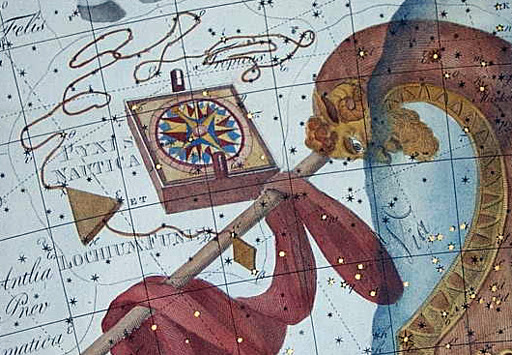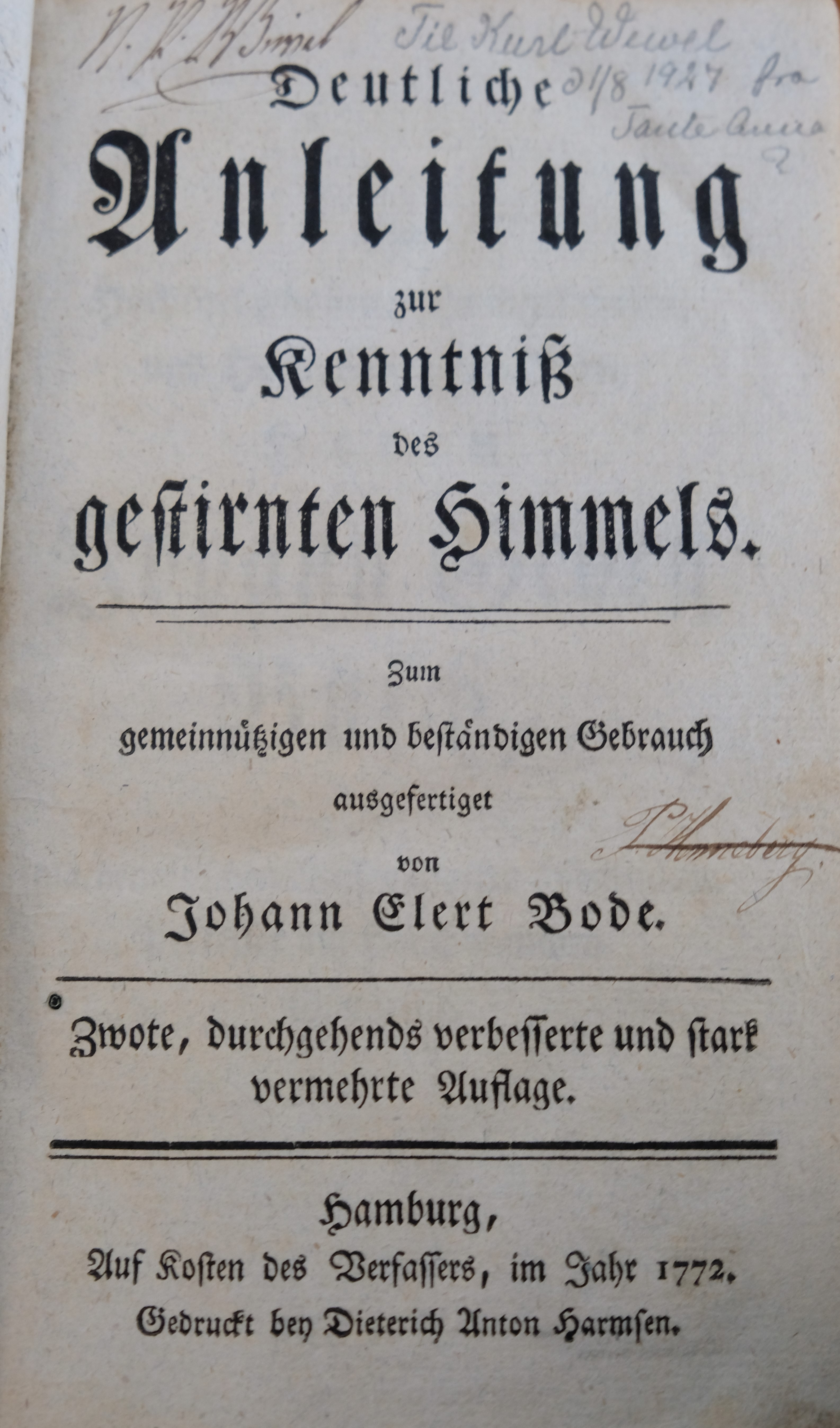|
Lochium Funis
Lochium Funis (Latin for ''the log and line'') was a constellation created by Johann Bode in 1801 next to the constellation Pyxis, an earlier invention of Nicolas Louis de Lacaille. It represented the log and line used by seamen for measuring a ship's speed through the water. It was never used by other astronomers. External links Lochium Funis Ian Ridpath Ian William Ridpath (born 1 May 1947, in Ilford, Essex) is an English science writer and broadcaster best known as a popularizer of astronomy and a biographer of constellation history. As a UFO sceptic, he investigated and explained the Rendl ...'s Star Tales Former constellations {{former-constellation-stub ... [...More Info...] [...Related Items...] OR: [Wikipedia] [Google] [Baidu] |
Bode Pyxis
{{disam ...
Bode may refer to: People * Bode (surname) * Bode Miller (born 1977), American skier * Bode Sowande (born 1948), Nigerian writer and dramatist * Bode Thomas (1918–1953), Nigerian politician Geography * Böde, village in Zala County, Hungary * Bode, Iowa, city in Humboldt County, Iowa, United States * Bode, Nepal, city in Bhaktapur District, Nepal * Bode (river), a major river in Saxony-Anhalt, Germany, tributary of the Saale * Bode (Wipper), a small river in Thuringia, Germany, tributary of the Wipper Other * Bode (crater), lunar crater * Bode plot, graph used in electrical engineering and control theory * Bode (fashion brand), American clothing company See also * Bodie (other) * Bodhi The English term enlightenment is the Western translation of various Buddhist terms, most notably bodhi and vimutti. The abstract noun ''bodhi'' (; Sanskrit: बोधि; Pali: ''bodhi''), means the knowledge or wisdom, or awakened intellect ... [...More Info...] [...Related Items...] OR: [Wikipedia] [Google] [Baidu] |
Latin Language
Latin (, or , ) is a classical language belonging to the Italic languages, Italic branch of the Indo-European languages. Latin was originally a dialect spoken in the lower Tiber area (then known as Latium) around present-day Rome, but through the power of the Roman Republic it became the dominant language in the Italy (geographical region), Italian region and subsequently throughout the Roman Empire. Even after the Fall of the Western Roman Empire, fall of Western Rome, Latin remained the common language of international communication, science, scholarship and academia in Europe until well into the 18th century, when other regional vernaculars (including its own descendants, the Romance languages) supplanted it in common academic and political usage, and it eventually became a dead language in the modern linguistic definition. Latin is a fusional language, highly inflected language, with three distinct grammatical gender, genders (masculine, feminine, and neuter), six or seven ... [...More Info...] [...Related Items...] OR: [Wikipedia] [Google] [Baidu] |
Log (speed)
A chip log, also called common log, ship log, or just log, is a navigation tool mariners use to estimate the speed of a vessel through water. The word ''knot'', to mean nautical mile per hour, derives from this measurement method. History All nautical instruments that measure the speed of a ship through water are known as logs. This nomenclature dates back to the days of sail, when sailors tossed a log attached to a rope knotted at regular intervals off the stern of a ship. Sailors counted the number of knots that passed through their hands in a given time to determine the ship's speed. Today, sailors and aircraft pilots still express speed in knots. Construction A chip log consists of a wooden board attached to a line (the log-line). The log-line has a number of knots at uniform intervals. The log-line is wound on a reel so the user can easily pay it out. Over time, log construction standardized. The shape is a quarter circle, or quadrant with a radius of or , and thi ... [...More Info...] [...Related Items...] OR: [Wikipedia] [Google] [Baidu] |
Constellation
A constellation is an area on the celestial sphere in which a group of visible stars forms Asterism (astronomy), a perceived pattern or outline, typically representing an animal, mythological subject, or inanimate object. The origins of the earliest constellations likely go back to prehistory. People used them to relate stories of their beliefs, experiences, creation myth, creation, or mythology. Different cultures and countries adopted their own constellations, some of which lasted into the early 20th century before today's constellations were internationally recognized. The recognition of constellations has changed significantly over time. Many changed in size or shape. Some became popular, only to drop into obscurity. Some were limited to a single culture or nation. The 48 traditional Western constellations are Greek. They are given in Aratus' work ''Phenomena'' and Ptolemy's ''Almagest'', though their origin probably predates these works by several centuries. Constellation ... [...More Info...] [...Related Items...] OR: [Wikipedia] [Google] [Baidu] |
Johann Bode
Johann Elert Bode (; 19 January 1747 – 23 November 1826) was a German astronomer known for his reformulation and popularisation of the Titius–Bode law. Bode determined the orbit of Uranus and suggested the planet's name. Life and career Bode was born in Hamburg. As a youth, he suffered from a serious eye disease that particularly damaged his right eye; he continued to have trouble with his eyes throughout his life. His early promise in mathematics brought him to the attention of Johann Georg Büsch, who allowed Bode to use his own library for study. He began his career with the publication of a short work on the solar eclipse of 5 August 1766. This was followed by an elementary treatise on astronomy entitled ''Anleitung zur Kenntniss des gestirnten Himmels'' (1768, 10th ed. 1844), the success of which led to his being invited to Berlin by Johann Heinrich Lambert in 1772 for the purpose of computing ephemerides on an improved plan. There he founded, in 1774, the well-known ... [...More Info...] [...Related Items...] OR: [Wikipedia] [Google] [Baidu] |
Pyxis
Pyxis is a small and faint constellation in the southern sky. Abbreviated from Pyxis Nautica, its name is Latin for a mariner's compass (contrasting with Circinus, which represents a draftsman's compasses). Pyxis was introduced by Nicolas-Louis de Lacaille in the 18th century, and is counted among the 88 modern constellations. The plane of the Milky Way passes through Pyxis. A faint constellation, its three brightest stars— Alpha, Beta and Gamma Pyxidis—are in a rough line. At magnitude 3.68, Alpha is the constellation's brightest star. It is a blue-white star approximately distant and around 22,000 times as luminous as the Sun. Pyxis is located close to the stars that formed the old constellation Argo Navis, the ship of Jason and the Argonauts. Parts of Argo Navis were the Carina (the keel or hull), the Puppis (the poop deck or stern), and the Vela (the sails). These eventually became their own constellations. In the 19th century, John Herschel suggested renaming ... [...More Info...] [...Related Items...] OR: [Wikipedia] [Google] [Baidu] |
Nicolas Louis De Lacaille
Abbé Nicolas-Louis de Lacaille (; 15 March 171321 March 1762), formerly sometimes spelled de la Caille, was a French astronomer and geodesist who named 14 out of the 88 constellations. From 1750 to 1754, he studied the sky at the Cape of Good Hope in present-day South Africa. Lacaille observed over 10,000 stars using just a half-inch refracting telescope. Biography Born at Rumigny in the Ardennes in eastern France, he attended school in Mantes-sur-Seine (now Mantes-la-Jolie). Afterwards, he studied rhetoric and philosophy at the Collège de Lisieux and then theology at the Collège de Navarre. He was left destitute in 1731 by the death of his father, who had held a post in the household of the duchess of Vendôme. However, he was supported in his studies by the Duc de Bourbon, his father's former patron. After he graduated, he did not accept ordination as a priest but took deacon's orders, becoming an Abbé. He concentrated thereafter on science, and, through the patrona ... [...More Info...] [...Related Items...] OR: [Wikipedia] [Google] [Baidu] |
Ian Ridpath
Ian William Ridpath (born 1 May 1947, in Ilford, Essex) is an England, English science writer and broadcaster best known as a popularizer of astronomy and a biographer of constellation history. As a UFO sceptic, he investigated and explained the Rendlesham Forest Incident of December 1980. Life and career Ridpath attended Beal High School, Beal Grammar School in Ilford where he wrote astronomy articles for the school magazine. Before entering publishing he was an assistant in the lunar research group at the University of London Observatory, Mill Hill. He now lives in Brentford, Middlesex. He is editor of the ''Oxford Dictionary of Astronomy'' and Norton's Star Atlas, and author of observing guides such as ''The Monthly Sky Guide'' and the ''Collins Stars and Planets Guide'' (the latter two with charts by Wil Tirion, and both continuously in print for over 30 years). His other books include ''Star Tales'', about the origins and mythology of the constellations, and the children' ... [...More Info...] [...Related Items...] OR: [Wikipedia] [Google] [Baidu] |





